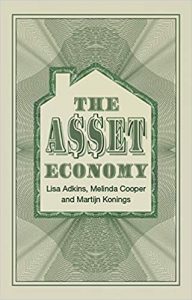In The Asset Economy, Lisa Adkins, Melinda Cooper and Martijn Konings retell the story of neoliberalism through the lens of assets, showing how asset ownership and asset inflation have been driving forces behind inequality and new class divides. This book is a highly readable and timely intervention in the burgeoning debate on rentiership and will inspire future research in showing the importance of putting assets at the centre of analysis, finds Nils Peters.
The Asset Economy. Lisa Adkins, Melinda Cooper and Martijn Konings. Polity. 2020.
 Find this book (affiliate link):
Find this book (affiliate link):![]()
With 700,000 people leaving the capital in the last six months of 2020, London is witnessing an exodus. Those turning their backs on the capital are mostly non-UK born and typically lost their jobs in the hospitality sector during the pandemic. For those without income from work, London rents force a quick decision to either stay or leave. While this drastic choice epitomises the stress that declining wages and a housing bubble cause in renters’ lives, it also prompts us to consider what a difference owning your home makes these days.
Addressing this very issue, Lisa Adkins, Melinda Cooper and Martijn Konings argue in The Asset Economy that asset inflation, especially in the form of housing prices, is the driving force behind inequality and new class divides. They make this striking argument across only 92 pages, which gives this book a manifesto character. The three main chapters establish a critique of current critical approaches to finance, sketch out a brief history of the asset economy and introduce a new class scheme based on asset ownership.
Putting assets at the centre of capitalist dynamics means wrestling attention away from commodities. Existing analyses often frame capitalist development as an expansion of markets. Markets expand through the commodification of real and fictitious commodities. Among the latter, the exploitation of labour power provides the framework for social stratification. While potent analytically, the central weakness of this ‘market view’ is that commodity exchange is conceptualised as atemporal – all transactions are completed the moment they occur. But quite clearly, bar the most basic cash transactions, most economic exchange involves a certain time span between payment and delivery of goods. In other words, the creation of credit and debt are everyday phenomena, and this is what makes capitalism financial.
This insight underpins Adkins, Cooper and Konings’ critique of finance and becomes most visible in their views on asset price inflation, which contrasts with post-Keynesian approaches. The latter assume that value is created through production processes in the real economy using (or exploiting) labour power. Aberrations from this real value do occur but only because investors speculate about other investors’ thoughts: economist John Maynard Keynes’s famous ‘beauty contest’. Given sufficient time, however, prices will gravitate towards their ‘real’ value. Finance, by this account, only distorts an otherwise ‘robust capitalism based on the production of real things’. Any critique of finance is limited to conceptualising it as ‘speculative’ or ‘parasitic’.
But what if the beauty contest never ends? Arguing from a perspective inspired by the heterodox economist Hyman Minsky, the authors of The Asset Economy invite us to see ‘debt and speculation not as pathological features’ but instead as ‘the very stuff of capitalist life’ (19). If asset prices are not tied to fundamentals, explaining how institutions enable their inflation becomes the pressing task. The post-foundational view eschews a moralistic rentier critique in favour of an infrastructural analysis of asset ownership. Moving focus from rentiers to asset owners enables us to analyse how society beyond ‘the one percent’ becomes entrained with finance’s rhythm.

Adkins, Cooper and Konings retell the story of neoliberalism through the asset lens. The key dynamic that enabled the asset economy was asset price inflation paired with wage stagnation in the 1970s. Avoiding a market-centred discussion of deregulation, the authors foreground institutional change in the realm of tax policy (lower capital gains taxes), fiscal policy (lower levels of public spending) and monetary policy (vigilance about wage and price inflation; benign neglect of asset price inflation). This yielded the consolidation of an institutional regime, a deflationary coalition, which protects the interests of asset owners to this day.
These macro changes manifested themselves on the micro level in the transformation from the Keynesian to the Minskyian household (69). The latter pursues asset ownership by buying a house and using it as collateral to secure a loan. In this leveraged state, managing liquidity to service mortgages becomes the household’s main focus. Facing stagnant wages, the Minskyian household pursues asset ownership with the aim to generate capital gains through asset appreciation. In contrast to the imaginary of footloose finance darting around the world at short notice seeking out the highest returns, this in fact locks households into lengthy commitments.
While wages are still important (for instance, to service mortgages), the authors argue that owning your home has such a significant bearing on life that it warrants a rethinking of our class conception around asset ownership. They introduce a new class scheme which distinguishes between asset owners (investors, outright and mortgaged homeowners) and ‘churners’ (renters and the homeless). The common framing of asset ownership as an intergenerational conflict can potentially be challenged on this basis: is a renting boomer so much better off than a millennial who can expect to have their down payment paid for by their home-owning parents?
This book provides a terrific new perspective on how finance formats everyday life through asset price dynamics. Due to the book’s length, there are various points where a more detailed explanation would have been welcome. Which financial innovations by banks and central banks enabled households to meet liquidity requirements? How did the transition from the Keynesian to Minskyian household come about? However, as this book attempts to forge a new research agenda rather than provide a complete historical account of the asset economy, it is worth focusing on what this agenda could imply.
The explanatory power of the Minskyian household concept hinges on the number of homeowners with mortgages relative to outright homeowners and renters. How do these groups compare across time and countries? Empirical analysis might reveal that in some economies, the concept of a leveraged, liquidity-focused household more readily applies to the top and bottom quintiles of the household income distribution – which works against the aim of bringing the asset-owning middle class into the analysis. How can we counter this and maintain a wide analytical scope?
This problem points to the limits of the liquidity-focused Minskyian framework. It is a good method to identify the economic pressures instilled by leveraged asset ownership. But this comes at the cost of a political reading of housing assets as devices in which power relations materialise. Research should go beyond filling in the class scheme proposed in the book and aim to expose the mechanisms of oppression and control between groups in that scheme. It needs to explain power differentials between outright and leveraged asset owners, between investors and renters. To meet its political potency, any future analysis of class must be historical.
Finally, the authors put a strong focus on housing, but the critique and analytical tools developed here could be used in other realms where asset appreciation has played an important role. One could think of the decade-long bull market in tech stocks: while only affecting stock-owning households directly, indirect effects are felt through institutional investors like pension funds and insurances which depend on an inflating stock market for returns. Meanwhile companies buoyed by high valuations are in a worryingly powerful position.
The Asset Economy presents a highly readable, timely intervention in the burgeoning debate on rentiership. With its sharp critique of existing approaches, it is set to reach a wide readership across the social sciences. The COVID-19 pandemic seems to only have amplified the importance of putting assets at the centre of analysis, and this book will certainly inspire future research in this field.
Note: This review gives the views of the author, and not the position of the LSE Review of Books blog, or of the London School of Economics. The LSE RB blog may receive a small commission if you choose to make a purchase through the above Amazon affiliate link. This is entirely independent of the coverage of the book on LSE Review of Books.
Image Credit: Photo by Tierra Mallorca on Unsplash.







